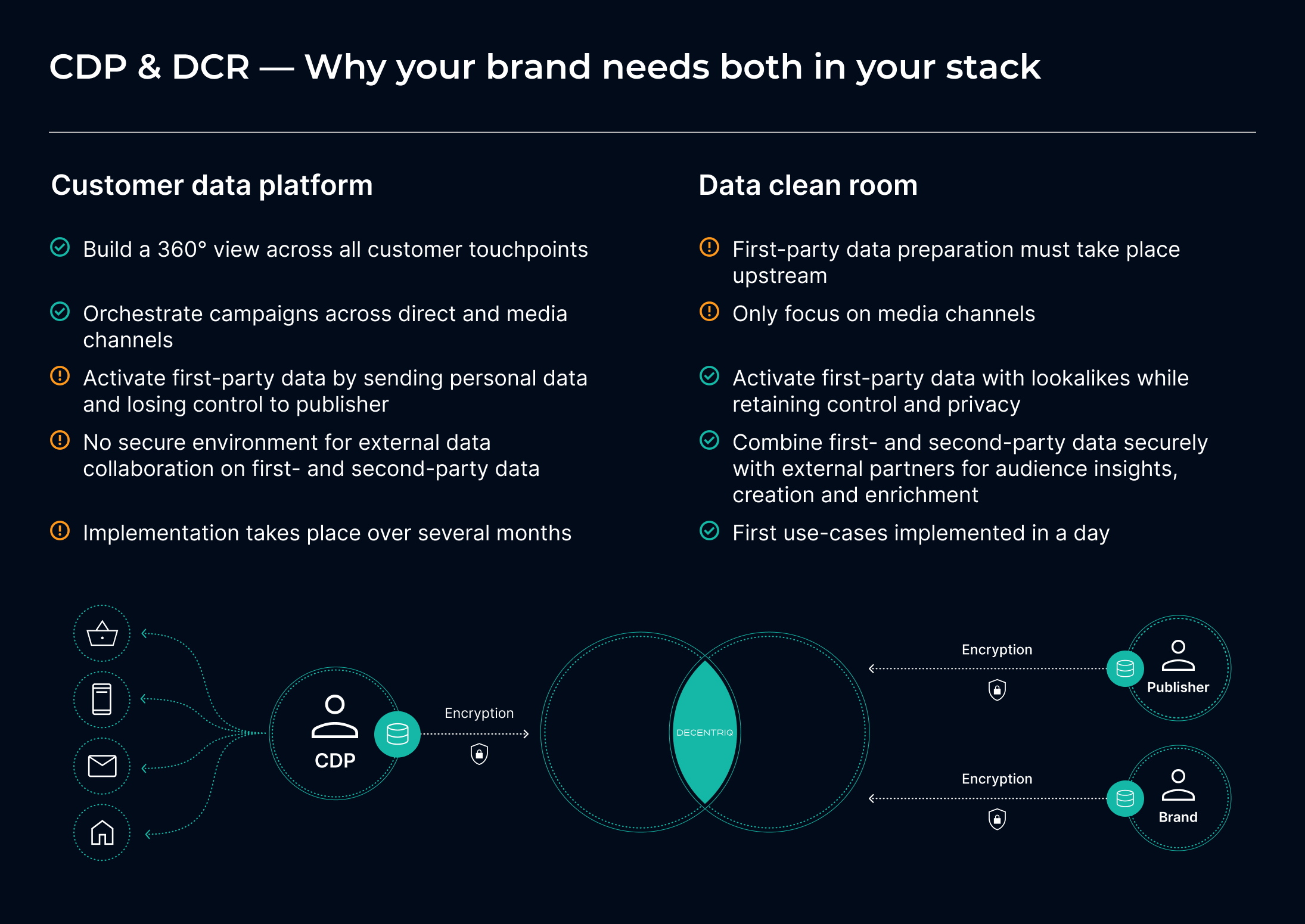%201%20(1).jpg)
Post-cookie prospecting playbook
Our playbook breaks down the current options available to brands for targeting audiences on the open web — and how they stack up when it comes to reaching net new customers.

Efficient use of customer data is vital for businesses to reach their prospective customers effectively. Customer data platforms (CDPs) and data clean rooms (DCRs) are two distinct tools to reach this goal, each with its unique strengths and capabilities.
Many know that CDPs offer a comprehensive view of customer touchpoints and seamless campaign orchestration, while DCRs enable organizations to open up beyond their own walls and collaborate externally.
Recently, some CDP providers have claimed to be extending into the DCR space by offering an environment for their customers to collaborate on first-party data. This has led some brands to believe that CDPs are now a one-stop shop for all their first-party data needs.
However, this isn’t the case, as CDPs often have weaker privacy guarantees and fewer capabilities regarding first-party data collaboration.
In this article, we delve into the strengths and weaknesses of CDPs and DCRs, arguing that both are essential components of a robust, future-proof data strategy.

What’s the difference between a CDP and a data clean room?
A customer data platform collects and unifies first-party customer data for internal use, like creating audience segments and enabling personalization. A data clean room enables secure, privacy-safe collaboration on data between multiple parties without exposing raw data.
In a nutshell:
- CDPs manage your own data
- Data clean rooms provide a safe space to analyze your own data combined with that of others
CDP and data clean rooms cover all campaign needs
Many brands are actively investing in setting up CDPs to navigate the challenges posed by third-party cookie deprecation. That’s because one of the primary advantages of CDPs is their ability to construct a 360° view across all customer touchpoints. This view makes CDPs very helpful in organizing customer data into one central repository that serves as a single source of truth.
By enabling businesses to collect valuable insights into customer behavior, preferences, and interactions, CDPs provide a much-needed boost to the brand’s first-party data.
And while many CDPs also offer options for first-party data activation with media platforms, the fact is they don’t do this in a sufficiently secure manner.
For example, a common method CDPs employ to deliver on these promises is sending personal data such as hashed emails to the ad platform. Brands relying on CDPs that use this method risk losing control and privacy with their collaboration partner. Still, working together on data is becoming increasingly necessary with the decline of third-party data quality.
This is where DCRs come in.
Privacy-preserving data clean rooms are the only solution enabling brands to activate first-party data on ad platforms in a fully secure and private way.
In using these types of DCRs, brands can mitigate the risks associated with direct data sharing and ensure compliance with privacy regulations. This enables use cases beyond mere activation, extending towards innovative collaborations combining first- and second-party data for audience insights, creation, and data enrichment.
By embracing capabilities offered by DCRs alongside their CDPs, brands can bridge the gap between targeting existing customers and reaching untapped audiences, thereby maximizing the effectiveness of their marketing efforts.
Standout use case: How CDPs and data clean rooms enable closed-loop marketing
Integrating customer data platforms with data clean rooms creates a closed-loop system that connects martech and adtech, enabling brands to activate audiences and measure performance across the full customer journey.
CDPs aggregate historical data and unify personally identifiable information (PII) into a centralized view, powering customer relationship management and segmentation. This enables marketers to create audiences from existing data, enriched with behavioral, transactional, and demographic signals.
However, CDPs alone are not designed for secure data collection and collaboration with external partners. As highlighted in the previous section, this is where data clean rooms play a critical role, offering a privacy-preserving environment for analyzing anonymized data, performing identity resolution, and securely collaborating on ID-based data for campaign targeting and performance insights.
Together, CDPs and clean rooms unlock:
- Actionable insights by matching internal and partner data without exposing raw PII
- Closed loop measurement by tying campaign outcomes back to individual audience segments
- Privacy-safe collaboration on prospecting customer data to target custom audiences across paid channels
- Enriched customer profiles by layering partner data on top of existing data
- Greater ROI through continuous optimization and deeper insights into what drives conversions
By closing the loop between data, activation, and outcome, this integration helps brands unlock data trapped in silos and turn it into high-performing, privacy-compliant campaigns across the funnel.
Example use case:
For example, a retail brand might use its CDP to identify high-value customers, then collaborate in a DCR with a media partner to find lookalike audiences and measure conversion uplift post-campaign — all without sharing sensitive data directly.
Can DCRs be used without having a CDP in place first?
It's important to note that brands can seamlessly integrate DCRs into their data strategies without having a pre-existing CDP. All that is required are identifiers, such as email addresses from a CRM or customer list, for matching purposes. The strength of DCRs lies in their flexibility — allowing brands to derive value even without an extensive dataset.
However, for brands seeking to unlock the full potential of DCRs, the recommendation is to incorporate the richer information made possible by a CDP. The better quality the dataset within the clean room is, the better results brands can expect from their collaborative efforts.
Speed of implementation
CDPs excel in seamlessly orchestrating marketing campaigns across direct and media channels. This ability to streamline marketing efforts ensures a cohesive and targeted approach. However, the implementation period for CDPs can be lengthy, stretching across several months.
With DCRs, implementation can be achieved within a day, making it an ideal solution for setting up advertising campaigns quickly. This is because DCRs often come with pre-built integrations with ad platforms and cloud storage, enabling brands to start testing campaigns in days rather than waiting months for a CDP rollout.
Embracing a hybrid approach
CDPs and DCRs should not be framed as an “either-or” scenario. Embracing a hybrid approach that leverages the strengths of both CDPs and DCRs is the key to enabling the full potential of customer insights in the new first-party future. It's not about choosing one over the other; it's about harnessing their complementary aspects to propel your data strategy forward.
FAQs
With many brands exploring newer solutions like data clean rooms for the first time, it’s natural to have questions about implementation, security, and practical outcomes. Below, we address some of the most frequently asked questions around using CDPs and DCRs concurrently.
How exactly do CDPs and data clean rooms work together?
CDPs collect and unify customer data, while data clean rooms allow brands to collaborate with partners (like media platforms) to enrich and activate that data — safely and privately. Together, they provide both internal data intelligence and external collaboration capabilities.
Why can’t a CDP replace a data clean room (and vice versa)?
A CDP is designed for managing first-party data within a company’s ecosystem, whereas a data clean room facilitates secure data collaboration between different entities. They serve complementary purposes and aren’t interchangeable.
Are data clean rooms only for large enterprises?
No. While originally used by large advertisers and publishers, modern clean room platforms are increasingly accessible to mid-size brands through SaaS models and user-friendly interfaces.
Is it safe to work with other parties in a clean room?
Yes. Clean rooms use privacy-enhancing technologies (PETs), such as differential privacy or secure multi-party computation (SMPC), to ensure that raw data is never exposed and that all analysis is privacy-preserving.
What are some use cases of CDPs and clean rooms working together?
Examples include measuring campaign effectiveness with a media partner, performing customer overlap analysis, enriching customer profiles with second-party data, and improving audience segmentation and targeting.
How do clean rooms support compliance with data privacy regulations?
They are designed to enforce strict access controls, anonymization, and purpose-based usage, making them a valuable tool for complying with GDPR, CCPA, and other privacy laws.
Can I use multiple clean rooms with a single CDP?
Yes. In fact, many brands do. CDPs can feed anonymized or pseudonymized data to multiple clean room environments, depending on which media partners or data collaborators they’re working with. Interoperability is a growing trend among modern martech solutions.
How do I get started integrating a CDP with a clean room?
Start by identifying your key data use cases. Choose a CDP that can export data in a privacy-compliant format, and work with a clean room provider (like Decentriq) that integrates with your data sources and media partners.
Ready to unlock the full potential of your first-party data?
Combine the precision of CDPs with the privacy and power of data clean rooms. Discover how Decentriq’s secure data collaboration platform enables smarter, privacy-safe advertising and measurement without compromising compliance or control. Explore Decentriq’s data clean room solution for advertisers.
References
Post-cookie prospecting playbook
Our playbook breaks down the current options available to brands for targeting audiences on the open web — and how they stack up when it comes to reaching net new customers.

Related content
Subscribe to Decentriq
Stay connected with Decentriq. Receive email notifications about industry news and product updates.




